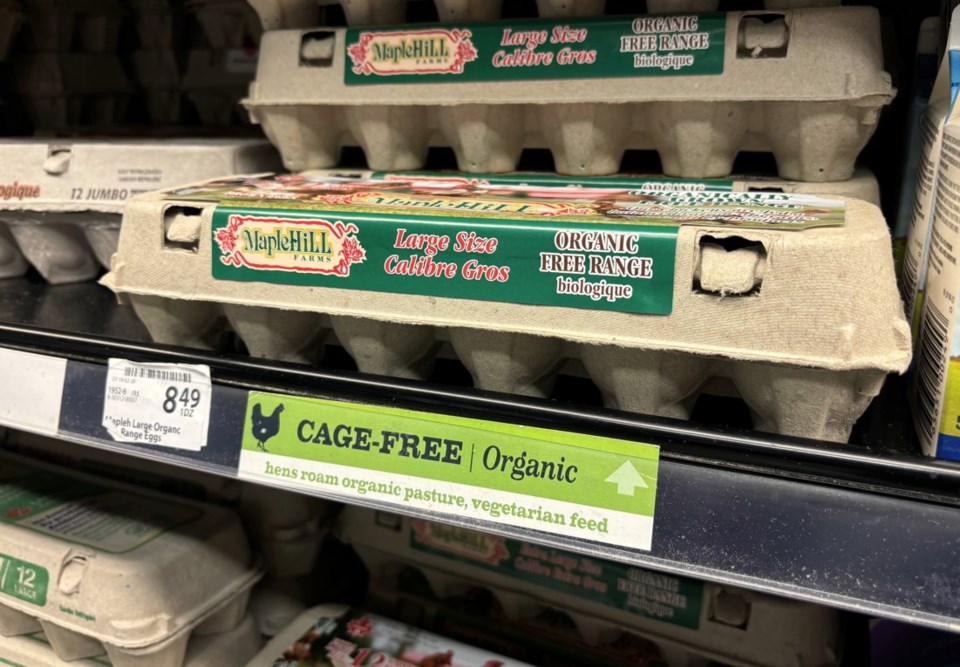Some Canadian restaurant chains are shifting to exclusively use free-run eggs, which are from hens that can roam barn floors, but in many grocery stores it can be tough for shoppers to easily detect between eggs from caged and from uncaged birds, according to a recent survey.
McDonald’s Canada on Monday (June 3) announced it is exclusively using free-run eggs in its McMuffin, bagel and McGriddles sandwiches.
Back in 2016, McDonald’s Canada pledged to achieve this target by 2025.
Other fast-food companies joined McDonald’s in that 2016 pledge, as did grocers, but success has been spotty.
A alleged that 83 per cent of the eggs that grocery giant Loblaw Cos. Ltd. (TSX:L) is selling are from caged chickens.
BIV emailed Loblaw for clarity on how close it is getting to phasing out selling eggs from caged chickens but has yet to receive a response.
On , Loblaw said that only 17 per cent of its egg sales were for eggs from uncaged hens.
“When these announcements are made, I never know for sure if it's actually true,” said Dalhousie University professor and director of the Agri-Food Analytics Lab Sylvain Charlebois about McDonald’s’ June 3 announcement.
“McDonald's is a massive organization and they do use a lot of eggs every day, so you never know for sure if there's some truth there or they're just bragging, or whatnot.”
His skepticism about the ability of large Canadian companies to be able to use and sell exclusively eggs from uncaged chickens stems from the complexity of the supply-management system in Canada, he said.
“You can’t just flip a switch in Canada,” he told BIV.
“Farming protocols are approved by farmer boards, and Loblaw has nothing to do with that, like zero.”
He said he believes that the industry is gradually shifting toward free-run and free-range eggs but that the process will take time because creating a supply chain that produces eggs exclusively from uncaged chickens requires farmers to make large capital investments and convert barns or build new ones.
Activist investors step in
There are activist investors who are pushing large companies to put pressure on their suppliers and demand that all the eggs they buy come from uncaged chickens.
“This is a serious concern,” Josh Balk, CEO of The Accountability Board told BIV.
“Consumers at Loblaws believe that the eggs from caged chickens come from cage-free housing systems because of the marketing on the cartons themselves.”
He pointed to the Research Co. survey, which his company sponsored.
It found mass confusion among shoppers as to whether eggs were from caged or uncaged chickens.
Survey conductor Mario Canseco told BIV that he showed respondents photos of various egg cartons, all of which contained eggs from caged chickens.
He and his team then asked them whether they thought the eggs were from caged or uncaged chickens.
One photo of a carton was of a dozen Burnbrae eggs branded Naturegg and carrying the descriptor “Nestlaid.”
Only 21 per cent of respondents thought the eggs were from caged chickens while 46 per cent thought they were from chickens living in open bars, while the rest said they were not sure.
The company’s that the eggs “come from hens raised in enriched colony housing. The hens live in small social groups and are free to perch, scratch and lay their eggs in a nesting area in a furnished cage environment.”
While these might be larger-than-average cages, they are still cages, said Balk, whose company owns shares in Loblaw as well as other major Canadian grocers.
Canseco’s team found a similar result when they showed respondents photos of a carton of Burnbrae eggs branded Naturegg and carrying the descriptor “Nature’s Best.”
Both of those cartons featured an animated egg sporting a smile, and a barn in a pastoral setting.
There was no mention of cages in any text on the cartons.
“People were inaccurate more than accurate when asked whether these eggs came from cage-free chickens or not,” Balk said. “That's a serious concern.”
It may well be that most people simply do not think about where their eggs come from and were simply guessing.
It may also be that if those people were in the egg sections of grocery stores where cage-free eggs were clearly identified, they would have had an easier time determining which eggs came from caged chickens.
At Save-On-Foods, for example, at least at the Cambie Street location, there was a sign yesterday on a shelf that said “Cage-free organic,” and had an arrow pointing up to a carton of eggs from Maple Hill Farms that said in a large font: “Organic free range.”
.
Research Co.'s survey asked people if they thought grocers should post colour-coded tags in the egg section to identify eggs from uncaged chickens and 82 per cent of respondents said that they should.
The survey did not ask respondents if they would buy eggs from uncaged chickens if they were able to determine what they were buying. It also did not ask how much more consumers would be willing to spend on eggs from uncaged chickens, compared with eggs from caged chickens.
Canseco said the questions were determined by Balk, and Balk said that getting a sense of demand for uncaged chicken eggs, and how much more consumers would be willing to spend to buy them, was not the point of the survey. The survey’s point was to simply to show if marketing was deceptive, he said.
“When you read [the survey,] it just feels that the intent was very is very much about activism and not necessarily about understanding what consumers are thinking,” Charlebois said.
“It seems as though participants were directed and influenced in some way in how the phrasing of some of these questions were.”

